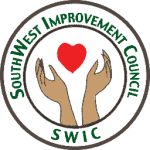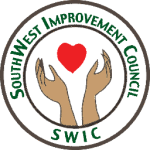Read Keynote Speech by SWIC’s Jan Marie Belle @ INC Delegate Meeting, 5/9/15
Our May Denver INC Delegate meeting was hosted by the South West Improvement Council, and our members responded well to the impassioned plea for citywide support for a worthy but beleaguered organization. The following is the text of the presentation:
Jan Marie Belle, Keynote speech, Inter-Neighborhood Cooperation Delegate Meeting, May 9, 2015
Welcome to SouthWest Improvement Council and the Westwood Community Center. The Westwood Community Center is owned by the City of Denver and operated by SWIC under a long-delayed lease purchase agreement between the City and SWIC.
This facility, originally named the SouthWest Denver Community Center, was formed by Grace Methodist Church who purchased the land 1930’s because they saw the need for a community center in this area. The community center cornerstone was laid in 1957.
In the 1970’s, the City of Denver purchased the Center and leased it back for $1 per year to the SouthWest Community Center Board. In return, the City obtained Model Cities’ monies to build a library, health clinic and child care center.
In the late-1980’s, the Southwest Community Center board had difficulty paying the utility bills and other obligations. The Board split, with both factions claiming to be the ‘real’ board with access to the bank accounts. As a result, the City renamed this facility the Westwood Community Center, and chose one of the factions to be the ones receiving the mail and having access to the bank accounts.
More lessees followed. All had difficulty paying the utility bills from the cash flow of the building rentals.
Meanwhile, neighborhood residents through St. Anthony of Padua Catholic Parish here in Westwood formed the St. Anthony Social Concerns committee, which I chaired, to take action on neighborhood concerns, such as low levels of educational attainment. SWIC was formed in 1986-1987 as an outgrowth of the St Anthony of Padua Catholic parish Social Concerns Committee. Fr. Patrick Sullivan helped me get a year’s severance pay from SEIU Local 105 (where I was President) so that we had money to start SWIC. Our first office was in a room behind the sacristy. Fr. Joseph Sullivan was our first board president and helped us get our first grant, from the Bal Swan Foundation.
SWIC always wanted to be in this community center. Finally, in 1992, our chance came when yet another lessee bowed out due to inability to pay the utility bills. There were no other takers. I had to personally guarantee the utility bills would be paid (to this day SWIC’s Utility bill comes to the attention of Jan Marie Belle), and raise $10,000 for a security deposit with Public Service Company of Colorado (now Xcel). The facility by this time was in a serious state of disrepair.
Bringing these conditions to the attention of The City, the City of Denver decided in 1996 to float the Citizen’s Neighborhood Bond Project (1998). This was under Mayor Wellington Webb. I worked tirelessly on that committee (well, sometimes not too tirelessly—it was exhausting!). I became co-chair of the southwest Denver bond committee. We had to get every project on this bond issue passed city wide to get our project, the re-construction of to the Westwood Community Center.
We got that bond issue passed city-wide in 1998. Then nearly 10 years of political drama ensued, as efforts were made to move the money from rebuilding the Westwood Community Center to projects other than those approved by the voters. I discovered that, by majority vote, City Council can move money from one project (what was voted) to a different project. I call this “bait and switch taxation”. We worked very hard to prevent that switch from happening.
Then, in 2000, the city decided to put the community centers out to bid. The idea was the city did not want the expense of maintaining community centers. Nonprofits were asked to bid. Of course, SWIC bid for the Westwood Community Center. This is our home!
After much drama which was featured in Westword article called “Centers of Controversy”, and after many delays, a contract passed city council that SWIC could purchase this facility. More delays. It was decided by the City that only after the 1998 bond project had been completed could our lease-purchase go through. More delays. Upgrading this facility (reconstructing) was the LAST of the 1998 bond projects to commence, with construction finally beginning under the administration of Mayor John Hickenlooper in the summer of 2005, and finishing in 2007.
The new lease-purchase agreement was held up. We were here without a contract, on a month-to-month basis. The city put more conditions on the lease purchase agreement. Finally, a new lease-purchase contract passed city council in November 2010. We had a contract to purchase in 2012. 2012 came and went.
In 2014, the city called to say they’ve decided not to sell the building after all, that they might use it in the future for an office building. We are back to operating month-to-month under the existing lease-purchase agreement.
Even having things in writing, signed by the Mayor, does not mean that things will happen as agreed.
Sometimes I think we were used for our community organizing skills just to get that 1998 bond issue passed. I served on the Denver planning board for 10 years. I remember so clearly when unwanted development was slated for Baker Neighborhood. The residents came with their Neighborhood Plan, pointing out that the plan they’d worked so hard to develop prohibited the developer’s desires. That’s when I learned that Neighborhood Plans are “Advisory Only”. That plans do not necessarily prevent, or prohibit anything.
Citizens of good will have spent hours and hours of unpaid time in endless meetings over years of time. Are citizen inputs and processes are really top-down manipulation strategies masquerading as public input to legitimate what’s already decided, to discern what are the best arguments against what is already decided?
So that TPB–The Powers That Be– can best hone their arguments to meet citizen objections?
At some point, we have to let that anxiety and resentment go. We are a charity. We are here to help people who are vulnerable. We directly serve people who live with low incomes in challenged communities. For as long as we are here, we will help people: With food banks, hot meals, gardens, foreclosure prevention, rental housing, civic engagement, positive alternatives for youth, and special events like hosting INC.
That brings us to today. Eric Sonderman commented that when people no longer trust the status quo, and there is a viable alternative, they will choose that alternative. We need more viable alternative choices. As we individual citizens look to the next four years, we see increases in property taxes, mill levies, fees and the like. For example, you by now have received your new property valuations—based on Denver’s speculative housing market. Appreciation in ‘Assessed Valuation” is non-cash income. Payment of taxes based on appreciation is a cash expense right out of our pockets.
Will we be paying more to keep our houses? YES. Has the income of Denver residents appreciated, or increased, at the same rate as housing prices? NO.
To be fair for everyone, the pay of city elected officials should be a percentage over the average income of Denver residents. To be fair, the property taxes should only be raised by the amount of increase in the average income of Denver Residents. Real Denver median household income peaked in 2007 at $66,145. The current median household income for Denver is $62,760—a decline since 2007 of $3,385 or 5.12% lower (SOURCE: Census Bureau ACS Survey for 2013, the latest figures available—2014 data will be released in September of 2015).
Spending 30% of one’s income for housing means the median Denver household income of $62,760 could spend 18,828 per year, or 1,569 per month for rent or a house payment. Finding family housing at that price in Denver is becoming difficult to almost impossible.
Average household income (latest data) for the neighborhood in which SWIC is located is $39,961. Spending 30% of this amount of income for housing means just under $1,000 per month for rent or a housing payment. Even with a public subsidy, working families cannot find affordable rental housing. Low income households can qualify for section 8 housing vouchers to help with rent, however, landlords can charge (and get) a higher rent than Section 8 will allow. So they won’t accept Section 8.
In summary, SWIC is still here at the Westwood Community Center serving the households who, despite their incomes, are struggling to keep a roof over their heads. We hope to be safe in our continued service to the community. We can be thrown out at any time. Recall that the City said they might want this building in the future for office space. But they will give us ten days’ notice. Of course, we think it best for the City of Denver that SWIC stay right here helping people “In Perpetuity”.
I will close by remembering a quote that was painted on a wall in Denver in the late1970”s– “Everyone Wants to Live at the Expense of the State. They Forget that the State Lives at the Expense of Everyone”.
Thank you, fellow and Sister INC’sters, for all you for the People of Denver.
“To give away money is an easy matter in any man’s power. But to decide to whom to give it, and how large and when, and for what purpose and how, is neither in every man’s power nor an easy matter.” — Aristotle
![]()





Comments
Read Keynote Speech by SWIC’s Jan Marie Belle @ INC Delegate Meeting, 5/9/15 — No Comments
HTML tags allowed in your comment: <a href="" title=""> <abbr title=""> <acronym title=""> <b> <blockquote cite=""> <cite> <code> <del datetime=""> <em> <i> <q cite=""> <s> <strike> <strong>